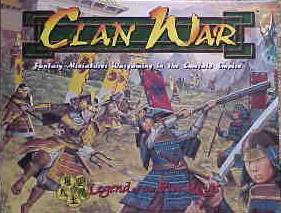
Clan War

- Description
- Detailed Description
- Reviews
- Links
Back to FANTASY MASS-COMBAT RULES
Legends of the Five Rings is a fantasy game setting based on ancient Japanese culture, and is the foundation for a collectible card game, a role-playing game, and a miniatures combat game.
Armies belong to one of six Clans, and are constructed using a point system. Each of the clans has access to the same basic troop types (peasant levies, ashigaru [trained peasants], infantry and cavalry) and leaders (chui [lieutenant], gunso [sergeant], and nikutai [corporal]), plus Unaligned characters and units (including goblins, dragons, ogres, necromancers, and monsters). In addition, there are characters and units which are particular to each clan (and which either cost more points or are prohibited to armies from other clans).
The available troops and characters are described on the Force Cards, with the same material also available in The Clans booklet. Units have a troop cost, maximum unit size, equipment, game stats, and any special rules; many units are also limited in total number of units allowed per army. Personalities are individuals, and their cards provide similar information (but include more game stats). Characters are leaders (attached to units), shugenja (spellcasters, optionally accompanied by yokimbo bodyguards), or individuals (loners, not allowed to associate with a unit).
Force design also includes the tailoring of an appropriate deck of Tactical Fate cards. These cards, when played, represent "special maneuvers, actions and effects." Each player's Tactical Deck must consist of exactly 30 cards.
The game is played in a series of turns, each of which is made up of several phases (initiative/orders/movement/cavalry movement/ranged attack/close combat/reserve movement/clean-up). At the start of the turn, dice are rolled for each unit to determine its current initiative - all units (of both players) will take action in initiative order in the following phases.


In general, units can move 4" per movement phase. Cavalry (and certain "fast" infantry) move in both the "primary" and Cavalry movement phases. In addition, units which are not in close proximity to the enemy may move a third time, in the Reserve Movement phase. Units are usually formed into groups between 4 and 12 figures wide, and no more than 6 models deep. Units can also form into column (for faster movement) or archer's row (allows more figures to fire). Maneuvers allow a unit to wheel, back up, or retreat, but success is dependant on the unit's training level.
To resolve combat, the attacker must roll equal or greater than the enemy's Target Number (TN), with modifiers applying as specified on the attacker's Force Card. In ranged combat, usually only the first rank can fire, with one roll per figure. With close combat, any model in contact with the enemy may attack, and usually rolls 1 or 2 dice per figure (as stated on the Force Card). For each successful hit, a Damage roll is made. All damage against a unit is totaled, then divided by 10 to determine total Wounds inflicted. A single Wound will kill most infantry, but Personalities may require several Wounds to kill.
Units may be Ready (normal), Spent (temporarily exhausted, generally after performing a special action), Broken (after failing a Morale test), or Routed (what happens when a Broken unit fails a Morale test...). Units are restored to good morale by a successful Rally attempt (during the "clean-up" End Phase).
An important aspect of play is the use of special abilities, Tactical Fate cards, and spells. These can take place in any phase, though usually at a set moment and in a certain order. Tactical Cards are dealt out per turn, and may be held in the hand, or "passed down" to specific Personalities. Shugenja purchase their spells prior to play, from a list of 20+ spells in four categories (Air, Earth, Fire, Water).
Special rules allow for duels between Personalities, fear, and allow Personalities to spend Void points to gain a re-roll, heal a Wound, or perform other actions. Optional rules add varied movement based on armor, push backs, damage rounding, and allow extra Tactical Cards due to earned Honor. Rules allow the creation of custom Personalities.
Except for specific scenarios, victory is determined by Victory Points. These are awarded for destruction of enemy units (based on point cost), destruction of enemy Personalities (based on their Glory ratings), and for possessing terrain objectives.